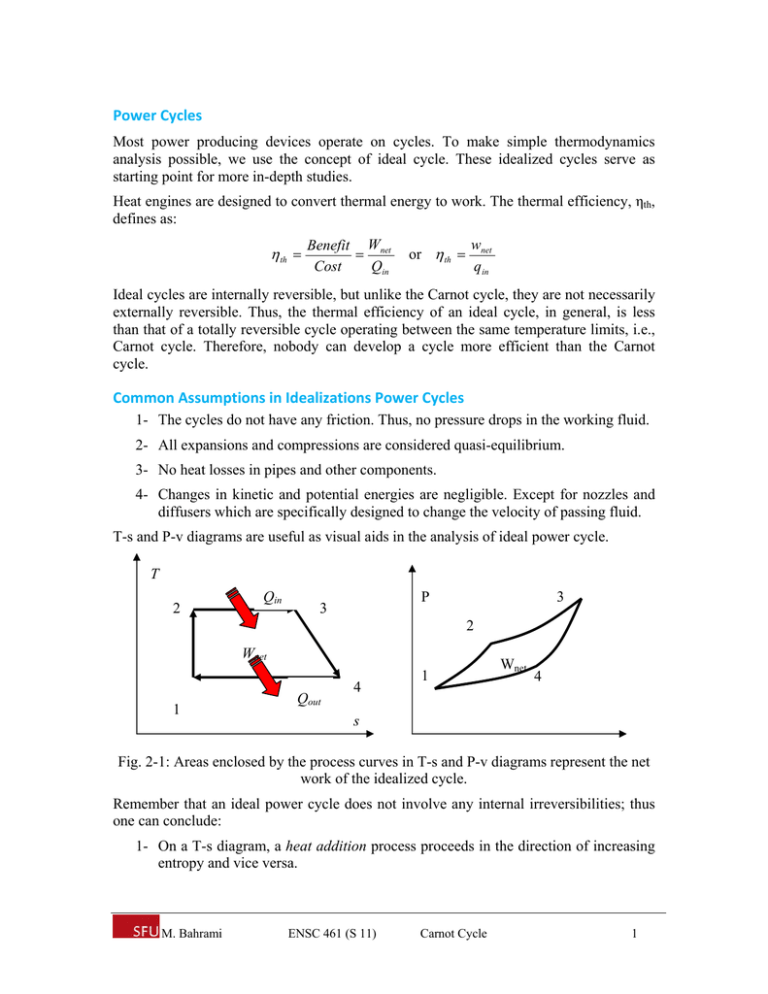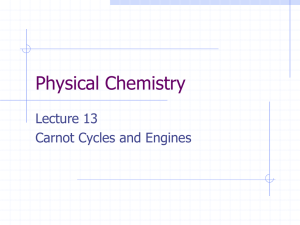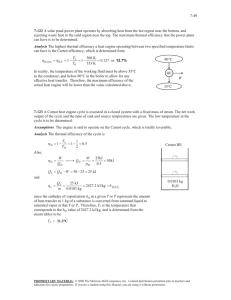Power Cycles
advertisement

Power Cycles Most power producing devices operate on cycles. To make simple thermodynamics analysis possible, we use the concept of ideal cycle. These idealized cycles serve as starting point for more in-depth studies. Heat engines are designed to convert thermal energy to work. The thermal efficiency, ηth, defines as: th Benefit Wnet Cost Qin wnet q in or th Ideal cycles are internally reversible, but unlike the Carnot cycle, they are not necessarily externally reversible. Thus, the thermal efficiency of an ideal cycle, in general, is less than that of a totally reversible cycle operating between the same temperature limits, i.e., Carnot cycle. Therefore, nobody can develop a cycle more efficient than the Carnot cycle. Common Assumptions in Idealizations Power Cycles 1- The cycles do not have any friction. Thus, no pressure drops in the working fluid. 2- All expansions and compressions are considered quasi-equilibrium. 3- No heat losses in pipes and other components. 4- Changes in kinetic and potential energies are negligible. Except for nozzles and diffusers which are specifically designed to change the velocity of passing fluid. T-s and P-v diagrams are useful as visual aids in the analysis of ideal power cycle. T 2 Qin P 3 3 2 Wnet 1 Qout 4 1 Wnet 4 s Fig. 2-1: Areas enclosed by the process curves in T-s and P-v diagrams represent the net work of the idealized cycle. Remember that an ideal power cycle does not involve any internal irreversibilities; thus one can conclude: 1- On a T-s diagram, a heat addition process proceeds in the direction of increasing entropy and vice versa. M. Bahrami ENSC 461 (S 11) Carnot Cycle 1 2- The area under the process curve on a T-s diagram represents the heat transfer for that process. 3- The area enclosed by the process curve on both T-s and P-v diagrams represent the net work of the cycle. 4- The ratio of the area enclosed by the cyclic curve to the area under the heataddition process curve represents the thermal efficiency of the cycle. 5- On a T-s diagram, a vertical line represents an isentropic process (no heat transfer and reversible). The Carnot Cycle The Carnot cycle is the most efficient power cycle and it is composed of four totally reversible processes: P 1 qin T qin TH= Const. 1 2 2 Isentropic Isentropic Isentropic 4 qout TL= Const. 4 3 qout v Isentropic 3 s Fig. 2-2: P-v and T-s diagrams for the Carnot cycle (in a cylinder-piston). Process 1-2, isothermal heat transfer (heat supply): heat is supplied at constant temperature TH Process 2-3, isentropic expansion (work output): air expands isentropically from the high pressure and temperature to the low pressure and temperature Process 3-4, isothermal heat transfer (condenser or heat rejection): heat is rejected at constant temperature TL Process 4-1, isentropic compression (work in): the air compresses isentropically to the high pressure and temperature. Thermal efficiency of the Carnot cycle can be calculated from: th ,Carnot 1 M. Bahrami ENSC 461 (S 11) TL TH Carnot Cycle 2 Carnot cycle is not limited to processes of a closed system taking place in a pistoncylinder assembly. Figure 2-3 shows the schematic and accompanying P-v diagram of a Carnot cycle executed by water steadily circulating through a simple vapor power plant. P TH 1 4 TL 3 2 v Fig. 2-2: Carnot vapor cycle. 1-2: The steam exiting the boiler expands adiabatically through the turbine and work is developed. The steam temperature decreases from TH to TL 2-3: Two-phase mixture flows through boiler where heat rejection occurs at constant temperature TL. 3-4: The mixture (liquid-vapor) enters the pump (or compressor) and its pressure increases. This is an adiabatic process and requires input work. 4-1: The saturated liquid at high pressure enters the boiler, where a change of phase (from liquid to vapor) occurs at constant temperature TH (isothermal heat transfer). Carnot cycles are not encountered in reality since achieving isothermal heat transfer is very difficult (needs very large heat exchangers and long time). Also process 3-4 requires a pump or compressor that can handle two phase mixture (liquid and vapor) which is impractical. The real value of the Carnot cycle comes from its being a standard against which the actual or ideal cycles can be compared. M. Bahrami ENSC 461 (S 11) Carnot Cycle 3






